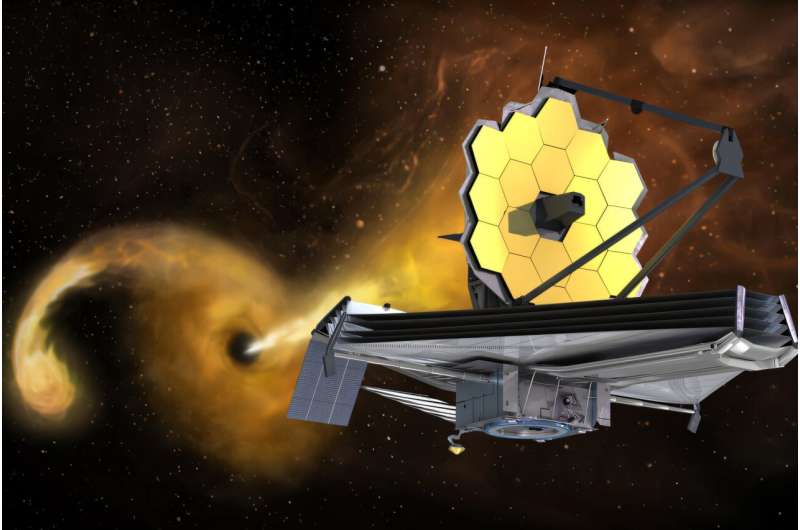Science
JWST Reveals Hidden Black Holes Consuming Stars in Dusty Galaxies

Astronomers from the Massachusetts Institute of Technology (MIT) and Columbia University have made a significant breakthrough using NASA’s James Webb Space Telescope (JWST) to observe black holes consuming stars in dusty galaxies. Their findings, published on July 24, 2025, in the *Astrophysical Journal Letters*, reveal several tidal disruption events (TDEs) that had previously gone undetected due to the obscuring effects of interstellar dust.
Traditionally, astronomers have identified around 100 TDEs since the 1990s, mostly through X-ray or optical emissions observable in less dusty environments. However, the new research indicates that many more such events may exist in galaxies shrouded in dust and gas, which can obscure the initial bursts of energy produced when a black hole tears apart a nearby star.
In previous studies, the research team established that the light emitted during a TDE is often hidden by a galaxy’s dust. Yet, this same burst of light can warm the surrounding material, generating infrared signals detectable by advanced telescopes. With JWST, the researchers examined four dust-enshrouded galaxies suspected of harboring TDEs, successfully identifying clear markers of black hole accretion. This discovery signifies a shift in understanding the environments surrounding both active and dormant black holes.
Megan Masterson, a graduate student at MIT’s Kavli Institute for Astrophysics and Space Research, expressed excitement about the findings. “These are the first JWST observations of tidal disruption events, and they look nothing like what we’ve ever seen before,” she stated. The research team included notable authors such as Christos Panagiotou, Erin Kara, and Anna-Christina Eilers, as well as Kishalay De from Columbia University.
Uncovering the Infrared Signals
This latest study builds upon earlier work utilizing NASA’s NEOWISE mission, which also focused on infrared detection. The team applied an algorithm to a decade of NEOWISE data, searching for transient infrared signals that could indicate a black hole awakening to consume a passing star. They identified approximately a dozen potential TDE candidates.
Masterson noted, “With that study, we found these 12 sources that look just like TDEs. We made a lot of arguments about how the signals were very energetic, and the galaxies didn’t look like they were active before, so the signals must have been from a sudden TDE. But except for these little pieces, there was no direct evidence.”
The enhanced sensitivity of JWST allowed the researchers to confirm key spectral lines indicative of black hole accretion. This process results in a swirling disk of gas and debris around the black hole, producing intense radiation that can release electrons from atoms. Notably, the accretion process generates specific infrared signals that JWST can detect, thereby confirming the presence of TDEs.
Insights into Dormant Black Holes
The research focused on four specific TDE signals, including the closest TDE detected to date, located approximately 130 million light years away. Other notable signals exhibited bursts of X-ray light and high-speed gas movement around black holes. Each of these signals was confirmed to be associated with black hole accretion.
In investigating the nature of these events, the researchers sought to determine whether the accretion was a brief occurrence linked to a TDE or indicative of an active black hole. By mapping dust patterns in the galaxies, they found significant differences when compared to typical active galaxies, suggesting that the black holes in question were dormant rather than constantly active.
“The only thing these flares could be are TDEs,” Masterson concluded. The team’s ongoing research aims to uncover additional hidden tidal disruption events using both JWST and NEOWISE, with the hope that these discoveries will provide deeper insights into black hole properties, such as mass and spin.
As the study of TDEs continues to evolve, the MIT team is poised to contribute significantly to our understanding of these cosmic phenomena. Their work underscores the capabilities of JWST in revealing previously obscured aspects of the universe, paving the way for future discoveries in the field of astrophysics.
-

 Lifestyle5 months ago
Lifestyle5 months agoLibraries Challenge Rising E-Book Costs Amid Growing Demand
-

 Sports5 months ago
Sports5 months agoTyreek Hill Responds to Tua Tagovailoa’s Comments on Team Dynamics
-

 Sports5 months ago
Sports5 months agoLiverpool Secures Agreement to Sign Young Striker Will Wright
-

 Lifestyle5 months ago
Lifestyle5 months agoSave Your Split Tomatoes: Expert Tips for Gardeners
-

 Lifestyle5 months ago
Lifestyle5 months agoPrincess Beatrice’s Daughter Athena Joins Siblings at London Parade
-

 Science4 months ago
Science4 months agoSan Francisco Hosts Unique Contest to Identify “Performative Males”
-

 World5 months ago
World5 months agoWinter Storms Lash New South Wales with Snow, Flood Risks
-

 Science5 months ago
Science5 months agoTrump Administration Moves to Repeal Key Climate Regulation
-

 Business5 months ago
Business5 months agoSoFi Technologies Shares Slip 2% Following Insider Stock Sale
-

 Science5 months ago
Science5 months agoNew Tool Reveals Link Between Horse Coat Condition and Parasites
-

 Sports5 months ago
Sports5 months agoElon Musk Sculpture Travels From Utah to Yosemite National Park
-

 Science5 months ago
Science5 months agoNew Study Confirms Humans Transported Stonehenge Bluestones









